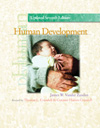 |  Human Development: Updated, 7/e James Vander Zanden,
Ohio State University
Thomas Crandell,
Broome Community College
Corinne Crandell,
Broome Community College
Middle Childhood 7 to 12: Physical and Cognitive Development
Chapter OutlineChapter 9 presents an overview of the advances in cognitive and moral development that occur during middle childhood. These changes are discussed within the context of the developing child during his or her elementary school years - ages 7 to 12. Several topics are covered, including:
1Physical Development. We look at growth and body changes, motor and brain development, health and fitness. Issues of bulimia, anorexia, giftedness, play and the role of exercise are all examined. |
 |  |  | 2Cognitive Development. This is a discussion of children's emerging cognitive capabilities, which permit them to organize and process environmental stimuli. Piaget's stage of concrete operations is presented as characterizing the elementary school child. An analysis of how children acquire socialization skills is also presented. Suggestions for recognizing and fostering creativity in children are highlighted |
 |  |  | 3Language Development. We further explore the mechanics of language as well as bilingual education in schools. Forms of bilingual education include English as a second language, bilingualism, and immersion. |
 |  |  | 4Learning Disabilities. Learning disabilities are covered, including ADHD, and educational responses are presented. |
 |  |  | 5Moral Development. The text presents the major theories used to understand children's moral development: psychoanalytic, cognitive learning, and cognitive-developmental theories. Also included is a review of the inconsistency of children's moral behavior, as well as the various personal and situational factors most closely associated with moral behavior. |
 |  |  | 6Prosocial Behavior. The chapter concludes with an overview of the ways in which children acquire prosocial behaviors. |
|



 2003 McGraw-Hill Higher Education
2003 McGraw-Hill Higher Education